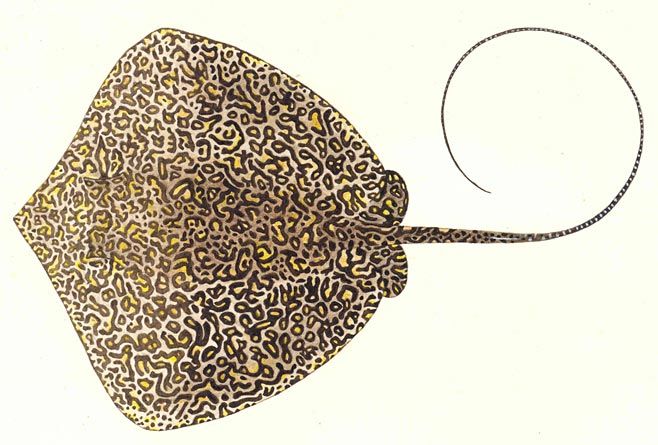|
Himantura cf. uarnak (Honeycomb stingray)
(Forsskål, 1775)
Life
> Eukaryotes >
Opisthokonta
> Metazoa (animals) >
Bilateria >
Deuterostomia > Chordata >
Craniata > Vertebrata (vertebrates) > Gnathostomata (jawed
vertebrates) > Chondrichthyes > Elasmobranchii > Batoidei >
Myliobatoidei >
Dasyatidae
 |
|
Himantura cf. uarnak (Honeycomb stingray) [Illustration
by Ann Hecht ©] |
Identification
A huge angular stingray with conspicuous dark
spots on a light brown disk, these well-spaced in young but crowded
to form a reticulated pattern in adults, and bands of black and
white on its tail. Snout sharply pointed, outer corners of disk
narrowly rounded, long slender tail nearly three times body length
when intact, no caudal finfolds, disk without thorns but with a band
of flat denticles along midback in adults and usually one
medium-sized sting on tail. Underside white.
Size
Up to 6 m TL
(mostly tail) and at least 2 m DW.
Range
East coast, East London to
Natal and Mozambique; Indian Ocean and western Pacific.
Habitat
Inshore in the tropics, frequents estuaries and may enter fresh
water but also occurs in the surf zone, in shallow bays, and
offshore down to 50 m.
Biology
Common off Natal, feeds on bottom
invertebrates, including bivalves, shrimp, crabs, and polychaete
worms. Bears 3 to 5 young in summer.
Human Impact
A popular angling
fish, prized for its powerful fight, but usually released unharmed.
Also caught by bottom trawlers and in beach seines.
Text by Leonard J.V. Compagno, David A. Ebert
and Malcolm J. Smale
|
